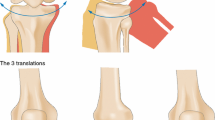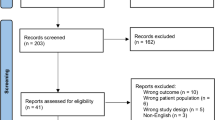Abstract
Introduction
Differences in total knee arthroplasty (TKA) patient demographics and clinical outcomes may exist between international regions, yet research is limited. The aim of this study was, therefore, to compare TKA patient demographics and patient-reported outcome measure (PROM) scores between the US, Scandinavia, and South Korea.
Materials and methods
A total of 398 TKA patients from three regions were assessed: 169 in Scandinavia (3 centers), 129 in the US (3 centers), and 100 patients in South Korea (2 centers). Regional variation in patient demographics was assessed using Kruskal–Wallis H tests. Regional variation in PROM scores from preoperative, 1-, 3- and 5-year visits was assessed using piecewise linear mixed effect models. The PROMs analyzed were a numerical rating scale for satisfaction and the Knee Osteoarthritis Outcome Score.
Results
South Korean patients were the oldest (p < 0.001) and had the highest Charnley class (p < 0.001); US patients had the highest BMI (p < 0.001); Scandinavian patients had the lowest preoperative KL grade (p < 0.001). Scandinavian patients were associated with better preoperative and worse postoperative PROM scores. Scandinavian patients were also associated with moderately lower levels of satisfaction. These differences were lessened but remained significant after controlling for relevant demographic and surgical factors.
Conclusions
Regional differences were found in TKA patient demographics and PROMs between the US, Scandinavia, and South Korea. The regional differences in patient demographics support the need for more research and clear guidelines related to TKA appropriateness criteria. The better preoperative and worse postoperative Scandinavian PROM scores may have been related to their less severe KL grade but might also reflect cultural differences in how patients reflect on their health state when answering PROMs. Clinicians should be aware of these international differences in PROM scores when interpreting studies conducted in different international regions. Future studies should investigate TKA variation between more international regions and assess intraregional variation.
Level of evidence
Level III.






Similar content being viewed by others
References
Healthcare Cost and Utilization Project (HCUP): Nationwide Inpatient Sample (NIS)
Koh IJ, Kim TK, Chang CB et al (2013) Trends in use of total knee arthroplasty in Korea from 2001 to 2010. Clin Orthop Relat Res 471:1441–1450. https://doi.org/10.1007/s11999-012-2622-y
NiemeläInen MJ, MäKelä KT, Robertsson O et al (2017) Different incidences of knee arthroplasty in the Nordic countries. Acta Orthop 88:173–178. https://doi.org/10.1080/17453674.2016.1275200
Katz JN, Winter AR, Hawker G (2017) Measures of the appropriateness of elective orthopaedic joint and spine procedures. J Bone Jt Surg Am 99:e15. https://doi.org/10.2106/JBJS.16.00473
Escobar A, Quintana JM, Aróstegui I et al (2003) Development of explicit criteria for total knee replacement. Int J Technol Assess Health Care 19:57–70
Escobar A, Quintana JM, Bilbao A et al (2007) Development of explicit criteria for prioritization of hip and knee replacement. J Eval Clin Pract 13:429–434
Riddle DL, Perera RA (2017) Appropriateness and total knee arthroplasty: an examination of the American Academy of Orthopaedic Surgeons appropriateness rating system. Osteoarthr Cartil 25:1994–1998. https://doi.org/10.1016/j.joca.2017.08.018
Riddle DL, Ghomrawi H, Jiranek WA et al (2018) Appropriateness criteria for total knee arthroplasty: additional comments and considerations. J Bone Jt Surg Am 100:e22. https://doi.org/10.2106/JBJS.17.00405
Baumann F, Krutsch W, Worlicek M et al (2018) Reduced joint-awareness in bicruciate-retaining total knee arthroplasty compared to cruciate-sacrificing total knee arthroplasty. Arch Orthop Trauma Surg 138:273–279. https://doi.org/10.1007/s00402-017-2839-z
McLean JM, Brumby-Rendell O, Lisle R et al (2018) Asymptomatic population reference values for three knee patient-reported outcomes measures: evaluation of an electronic data collection system and implications for future international, multi-centre cohort studies. Arch Orthop Trauma Surg 138:611–621. https://doi.org/10.1007/s00402-018-2874-4
Scott CEH, Wade FA, MacDonald D, Nutton RW (2018) Ten-year survival and patient-reported outcomes of a medial unicompartmental knee arthroplasty incorporating an all-polyethylene tibial component. Arch Orthop Trauma Surg 138:719–729. https://doi.org/10.1007/s00402-018-2908-y
Gromov K, Greene ME, Sillesen NH et al (2014) Regional differences between US and Europe in radiological osteoarthritis and self assessed quality of life in patients undergoing total hip arthroplasty surgery. J Arthroplasty 29:2078–2083
Gagnier JJ, Mullins M, Huang H et al (2017) Review: a systematic review of measurement properties of patient-reported outcome measures used in patients undergoing total knee arthroplasty. J Arthroplast 32:1688.e7–1697.e7
Dowsey MM, Nikpour M, Dieppe P, Choong PFM (2012) Associations between pre-operative radiographic changes and outcomes after total knee joint replacement for osteoarthritis. Osteoarthr Cartil 20:1095–1102. https://doi.org/10.1016/j.joca.2012.05.015
den Hertog A, Gliesche K, Timm J et al (2012) Pathway-controlled fast-track rehabilitation after total knee arthroplasty: a randomized prospective clinical study evaluating the recovery pattern, drug consumption, and length of stay. Arch Orthop Trauma Surg 132:1153–1163. https://doi.org/10.1007/s00402-012-1528-1
Giesinger JM, Loth FL, MacDonald DJ et al (2018) Patient-reported outcome metrics following total knee arthroplasty are influenced differently by patients’ body mass index. Knee Surg Sport Traumatol Arthrosc VO 26:3257. https://doi.org/10.1007/s00167-018-4853-2
Jiang Y, Sanchez-Santos MT, Judge AD et al (2017) Primary arthroplasty: predictors of patient-reported pain and functional outcomes over 10 years after primary total knee arthroplasty: a prospective cohort study. J Arthroplast 32:92.e2–100.e2
Haynes J, Sassoon A, Nam D et al (2017) Younger patients have less severe radiographic disease and lower reported outcome scores than older patients undergoing total knee arthroplasty. Knee 24:663–669
Charnley J, Halley DK (1975) Rate of wear in total hip replacement. Clin Orthop Relat Res 112:170–179
Mj D, Robertsson O, Ryd L (2004) What’s all that noise? The effect of co-morbidity on health outcome questionnaire results after knee arthroplasty. Acta Orthop Scand 75:119–126
Kellgren JH, Lawrence JS (1957) Radiological assessment of osteo-arthrosis. Ann Rheum Dis 16:494–502
Abdelaziz H, Balde OM, Citak M et al (2019) Kellgren–Lawrence scoring system underestimates cartilage damage when indicating TKA: preoperative radiograph versus intraoperative photograph. Arch Orthop Trauma Surg 139:1287–1292. https://doi.org/10.1007/s00402-019-03223-6
Gromov K, Korchi M, Thomsen MG et al (2014) What is the optimal alignment of the tibial and femoral components in knee arthroplasty? Acta Orthop 85:480–487. https://doi.org/10.3109/17453674.2014.940573
Zalzal P, Backstein D, Gross AE, Papini M (2006) Notching of the anterior femoral cortex during total knee arthroplasty: characteristics that increase local stresses. J Arthroplast 21:737–743. https://doi.org/10.1016/j.arth.2005.08.020
Roos EM, Toksvig-Larsen S (2003) Knee injury and Osteoarthritis Outcome Score (KOOS)—validation and comparison to the WOMAC in total knee replacement. Health Qual Life Outcomes 1:17. https://doi.org/10.1186/1477-7525-1-17
Roos EM, Roos HP, Ekdahl C, Lohmander LS (1998) Knee injury and Osteoarthritis Outcome Score (KOOS)—validation of a Swedish version. Scand J Med Sci Sports 8:439
Guillemin F, Bombardier C, Beaton D (1993) Cross-cultural adaptation of health-related quality of life measures: literature review and proposed guidelines. J Clin Epidemiol 46:1417–1432
Fitzmaurice G, Laird N, Ware J (2011) Applied longitudinal analysis, 2nd edn. Wiley, Hoboken
Kennedy DM, Hanna SE, Stratford PW et al (2006) Preoperative function and gender predict pattern of functional recovery after hip and knee arthroplasty. J Arthroplast 21:559–566
Kennedy DM, Stratford PW, Riddle DL et al (2008) Assessing recovery and establishing prognosis following total knee arthroplasty. Phys Ther 88:22–32. https://doi.org/10.2522/ptj.20070051
Nielsen CS, Nebergall A, Huddleston J et al (2018) medial overhang of the tibial component is associated with higher risk of inferior knee injury and osteoarthritis outcome score pain after knee replacement. J Arthroplast VO . https://doi.org/10.1016/j.arth.2017.12.027
Momoli A, Giarretta S, Modena M, Micheloni GM (2017) The painful knee after total knee arthroplasty: evaluation and management. Acta Biomed Atenei Parm 88:60–67. https://doi.org/10.23750/abm.v88i2-S.6515
Lesh ML, Schneider DJ, Deol G et al (2000) The consequences of anterior femoral notching in total knee arthroplasty. A biomechanical study. J Bone Jt Surg Am 82-A:1096–1101
Seon JK, Park JK, Jeong MS et al (2011) Correlation between preoperative and postoperative knee kinematics in total knee arthroplasty using cruciate retaining designs. Int Orthop 35:515–520. https://doi.org/10.1007/s00264-010-1029-1
King SW, Lamb JN, Cage ES, Pandit H (2018) Periprosthetic femoral fractures following total hip and total knee arthroplasty. Maturitas 117:1–5
Sugitani K, Arai Y, Takamiya H et al (2015) Factors affecting range of motion after total knee arthroplasty in patients with more than 120 degrees of preoperative flexion angle. Int Orthop VO 39:1535. https://doi.org/10.1007/s00264-015-2710-1
Sarmah SS, Patel S, Reading G et al (2012) Periprosthetic fractures around total knee arthroplasty. Ann R Coll Surg Engl 94:302–307. https://doi.org/10.1308/003588412X13171221592537
Hoorntje A, Witjes S, Koenraadt KLM et al (2018) More severe preoperative Kellgren–Lawrence grades of knee osteoarthritis were partially associated with better postoperative patient-reported outcomes in TKA patients. J Knee Surg. https://doi.org/10.1055/s-0038-1635114
Verra WC, van den Boom LGH, Jacobs WCH et al (2015) Similar outcome after retention or sacrifice of the posterior cruciate ligament in total knee arthroplasty. Acta Orthop 86:195–201. https://doi.org/10.3109/17453674.2014.973329
American Academy of Orthopaedic Surgeons (2019) American Joint Replacement Registry annual report 2018
Dowsey MM, Choong PFM, Paxton EW et al (2018) Body mass index is associated with all-cause mortality after THA and TKA. Clin Orthop Relat Res 476:1139–1148. https://doi.org/10.1007/s11999.0000000000000108
Lübbeke A, Silman AJ, Barea C et al (2018) Mapping existing hip and knee replacement registries in Europe. Health Policy (New York) 122:548–557. https://doi.org/10.1016/j.healthpol.2018.03.010
Deshpande BR, Katz JN, Solomon DH et al (2016) Number of persons with symptomatic knee osteoarthritis in the US: impact of race and ethnicity, age, sex, and obesity. Arthritis Care Res (Hoboken) 68:1743–1750. https://doi.org/10.1002/acr.22897
Ackerman IN, Osborne RH (2012) Obesity and increased burden of hip and knee joint disease in Australia: results from a national survey. BMC Musculoskelet Disord 13:254. https://doi.org/10.1186/1471-2474-13-254
Hame SL, Alexander RA (2013) Knee osteoarthritis in women. Curr Rev Musculoskelet Med 6:182–187. https://doi.org/10.1007/s12178-013-9164-0
McCrae RR, Terracciano A (2005) Personality profiles of cultures: aggregate personality traits. J Personal Soc Psychol VO 89:407
Karlsdottìr A, Rispling L, Norlén G et al (2018) State of the Nordic Region 2018: immigration and integration edition
Blackwell DL, Lucas JW, Clarke TC (2014) Summary health statistics for U.S. adults: national health interview survey, 2012. Vital Health Stat 10:1–161
Dunlop DD, Manheim LM, Song J et al (2008) Age and racial/ethnic disparities in arthritis-related hip and knee surgeries. Med Care VO 46:200
Robertsson O, Bizjajeva S, Fenstad AM et al (2010) Knee arthroplasty in Denmark, Norway and Sweden. A pilot study from the Nordic Arthroplasty Register Association. Acta Orthop 81:82–89. https://doi.org/10.3109/17453671003685442
Statistics Korea Korean Statistical Information Service
Funding
We received no funding for this specific analysis. Data collection for the cohort of patients included in this study has been supported with funding from Zimmer Biomet. The institutions and Zimmer Biomet signed a standard legal study agreement whereby economic support was granted unconditionally and the manufacturer would have no influence on study design, data analysis, or publication.
Author information
Authors and Affiliations
Corresponding author
Ethics declarations
Conflict of interest
Authors NS, VPG, PR, YECI, ISF, CSN, AK, and CRB report no conflicts of interest. Author HM reports board membership for and stock membership in RSA Biomedical, research support from Biomet, Smith & Nephew, DePuy, Zimmer, and MAKO, and royalties from Zimmer, Biomet, Corin, and RSA Biomedical. Author AT reports paid speakership, paid consultancy, and research support from Zimmer Biomet, as well as board membership or committee appointment for the European Knee Society (EKS).
Ethical approval
Institutional review board or local ethics committee approval was obtained at each center, and at the Academic Coordinating Research Organization.
Informed consent
Informed consent was obtained from all individual participants included in the study in accordance with the declaration of Helsinki.
Additional information
Publisher's Note
Springer Nature remains neutral with regard to jurisdictional claims in published maps and institutional affiliations.
Rights and permissions
About this article
Cite this article
Sauder, N., Galea, V.P., Rojanasopondist, P. et al. Regional differences between the US, Scandinavia, and South Korea in patient demographics and patient-reported outcomes for primary total knee arthroplasty. Arch Orthop Trauma Surg 140, 93–108 (2020). https://doi.org/10.1007/s00402-019-03286-5
Received:
Published:
Issue Date:
DOI: https://doi.org/10.1007/s00402-019-03286-5




